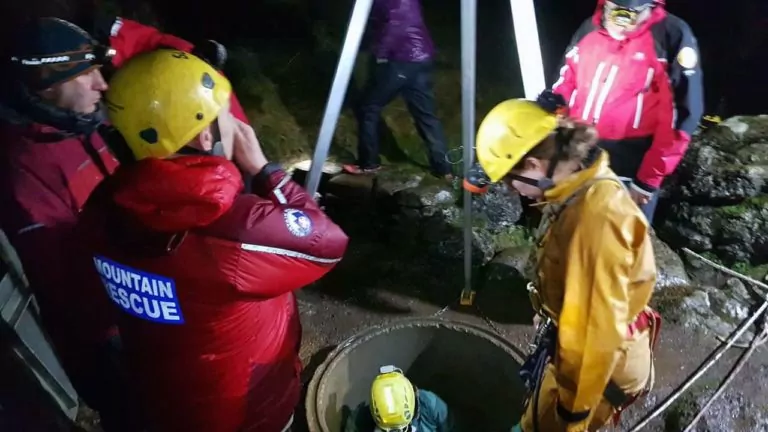DIVING NEWS
UK cave-diver died using unproven rebreather

Cave-rescue volunteers at the scene. (Picture: Cave Rescue Organisation)
An inquest has heard how a cave-diver in Cumbria drowned close to the surface early last year, after a problem was thought to have occurred with his rebreather, a unit under development.
Simon Halliday, 49, from Clitheroe, Lancs, died at Lancaster Hole near Kirkby Lonsdale on 4 January, 2020. The incident was reported on Divernet, although at that time the victim remained unnamed and was thought to have been older.
Lancaster Hole is an access point to the Three Counties System, one of England’s biggest networks of limestone caves which extends beneath Cumbria, Lancashire and the Yorkshire Dales.
Divers had been extending the downstream passage from the hole, exploring some 900m beyond the sump pool from which it was normally accessed.
Halliday was an experienced cave-diver, having resumed following a hiatus while on holiday in Egypt some two years before his death. He belonged to the Northern Section of the Cave Diving Group (CDG) and other groups.
He had travelled to the dive-site, which he had dived before, with two friends, David McDonough and Kevin Gannon. He told them that his planned solo dive would take no more than three hours, according to a report on the inquest at Cockermouth Coroner’s Court by the Westmoreland Gazette.
Halliday was using a rebreather said to be in development and so not commercially available. It had been supplied to him by sporting goods company Sump UK.
His friends waited four hours after his departure before raising the alarm. Cumbria police alerted the Cave Rescue Organisation and as many as 40 members and divers from the CDG were said at the time to have responded.
It was diver Anthony Seddon who discovered Halliday’s body, 14 minutes and 60m into the underwater passage. According to the press report, when Halliday was pulled out of the water, his “oxygen supply pipe” appeared to have been disconnected or ripped out, though whether this had occurred on the dive or during the recovery was uncertain.
However, data from Halliday’s dive computers “supported the idea that his rebreathing equipment had failed him” and that he had switched to his bail-out.
According to McDonough and Gannon more water had been flowing into the passageway than usual. Halliday was said not to have regarded this as an issue, but the current appeared to have increased while he was gone.
The inquest heard that this might have required him to fight against the flow on his way back, becoming stressed and using more air than expected. He could also have been fighting to avoid drifting up towards the ceiling as he became increasingly buoyant.
7 March 2021
Expert witness cave-diver Jason Mallinson said that the Sump UK-supplied rebreather had a straight fitting to the drysuit, whereas an elbow fitting with a 90-degree bend would have prevented it from unscrewing, if that was what had happened.
Halliday, who was married with two children, liked to “push himself” and “operate at the extreme”, McDonough told the court. Assistant coroner for Cumbria Dr Nicholas Shaw said it was “most likely” that Halliday’s rebreather had failed him and recorded a conclusion of misadventure, with drowning the medical cause of death.

